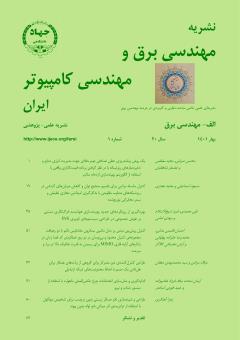کنترل پیشبین مبتنی بر مدل ماشین سنکرون مغناطیس دایم با دو رهیافت مجموعه کنترل محدود و بینوسان در دو ربع عملکردی
محورهای موضوعی : مهندسی برق و کامپیوتر
احسان قاسمی مدانی
1
,
محمدرضا علیزاده پهلوانی
2
,
آرش دهستانی کلاگر
3
![]()
1 - دانشگاه صنعتی مالک اشتر،مجتمع برق و کامپیوتر
2 - دانشگاه صنعتی مالک اشتر،مجتمع برق و کامپیوتر
3 - دانشگاه صنعتی مالک اشتر،مجتمع برق و کامپیوتر
کلید واژه: ماشین سنکرون مغناطیس دایم, کنترل پیشبین با مجموعه کنترلی محدود مبتنی بر مدل, کنترل پیشبین بینوسان مبتنی بر مدل, مدولاسیون پهنای پالس فضای برداری, خودروی الکتریکی,
چکیده مقاله :
در این مقاله، دو نوع کنترل پیشبین با نامهای کنترل پیشبین با مجموعه کنترلی محدود مبتنی بر مدل (FCS-MPC) و کنترل پیشبین بینوسان مبتنی بر مدل (Dead-Beat MPC)، به منظور کنترل جریان ماشین سنکرون مغناطیس دایم در حالت بازیابی انرژی برای کاربرد خودروهای الکتریکی اعمال و مقایسه شده است. استراتژی FCS-MPC بردار ولتاژ بهینه را انتخاب و پالسهای کنترلی را مستقیماً بدون استفاده از هیچ گونه مدولاتوری به اینورتر اعمال میکند و استراتژی Dead-Beat MPC با مدولاسیون پهنای پالس فضای برداری پیادهسازی شده است. عملکرد و نتایج هر دو نوع استراتژی با استفاده از نرمافزار سیمولینک متلب استخراج و با یکدیگر مقایسه گردیده است. مقایسه به طور عمده در دو حالت ماندگار و حالت گذرا انجام شده است. هر دو نوع استراتژی بر روی یک ماشین سنکرون مغناطیس دایم با پارامترهای یکسان و با حالت کاری مشابه اعمال شده است. نتایج نشان میدهد که نوسان جریان در حالت ماندگار در استراتژی DB-MPC کاهش بیشتری داشته و پاسخ حالت گذرا در استراتژی FCS-MPC سریعتر است.
In this paper, two schemes of model predictive control (MPC) method, named finite control set model predictive control (FCS-MPC) and dead-beat model predictive control (DB-MPC) as a continuous control set model predictive control (CCS-MPC) are applied and compared to control the current of a permanent magnet synchronous machine in energy recovery mode for the use of electric vehicles. The FCS-MPC strategy selects the optimal voltage vector and applies the control pulses directly to the inverter without using any modulators. In other side, DB-MPC is implemented through space vector pulse width modulation (SVPWM). The performance and results of both types of control strategies are extracted and compared using MATLAB Simulink software. The comparisons are made mainly in steady state and transient modes. Both control strategies are applied to a permanent magnet synchronous machine with the same parameters and with the same operating mode. The results show that the current steady state fluctuation is further reduced in the DB-MPC strategy and the transient state response is faster in the FCS-MPC strategy.
[1] A. Adib and R. Dhaouadi, "Modeling and analysis of a regenerative braking system with a battery-supercapacitor energy storage," in Proc. IEEE 7th Int. Conf. on Modeling, Simulation, and Applied Optimization, ICMSAO’17, 6 pp., Sharjah, United Arab Emirates, 4-6 Apr. 2017.
[2] A. Ahmed and S. Cui, "Control and analysis of regenerative power distribution on electrical variable transmission using fuzzy logic on HEV system," in Proc. IEEE Int. Conf. on Electrical Machines and Systems, 6 pp, Beijing, China, 20-23 Aug. 2011.
[3] Z. Kangkang, L. Jianqiu, O. Minggao, G. Jing, and M. Yan, "Electric braking performance analysis of PMSM for electric vehicle applications," in Proc. IEEE Int. Conf. on Electronic & Mechanical Engineering and Information Technology, , vol. 5, pp. 2596-2599, Harbin, China, 12-14 Aug. 2011.
[4] A. Adib and R. Dhaouadi, "Performance analysis of regenerative braking in permanent magnet synchronous motor drives," Adv. Sci., Technol. Eng. Syst. J., vol. 3, no. 1, pp. 460-466, 2018.
[5] P. Cortes, M. P. Kazmierkowski, R. M. Kennel, D. E. Quevedo, and J. Rodriguez, "Predictive control in power electronics and drives," IEEE Trans. on Industrial Electronics, vol. 55, no. 12, pp. 4312-4324, Dec. 2008.
[6] J. Rodriguez and P. Cortes, Predictive Control of Power Converters and Electrical Drives, John Wiley & Sons, 2012.
[7] S. K. Mohanty, D. Jena, and D. Patra, "Model Predictive Control," 2007.
[8] M. Siami, M. Amiri, H. K. Savadkoohi, R. Rezavandi, and S. Valipour, "Simplified predictive torque control for a PMSM drive fed by a matrix converter with imposed input current," IEEE J. of Emerging and Selected Topics in Power Electronics, vol. 6, no. 4, pp. 1641-1649, Dec. 2018.
[9] A. Formentini, A. Trentin, M. Marchesoni, P. Zanchetta, and P. Wheeler, "Speed finite control set model predictive control of a PMSM fed by matrix converter," IEEE Trans. on Industrial Electronics, vol. 62, no. 11, pp. 6786-6796, Nov. 2015.
[10] Y. Zhang, J. Zhu, and W. Xu, "Predictive torque control of permanent magnet synchronous motor drive with reduced switching frequency," in Proc. IEEE Int. Conf. on Electrical Machines and Systems, , pp. 798-803, Incheon, Korea, 10-13 Oct. 2010.
[11] J. W. Jung, J. J. Lee, S. O. Kwon, and J. P. Hong, "Equivalent circuit analysis of interior permanent magnet synchronous motor considering magnetic saturation," World Electric Vehicle J., vol. 3, pp. 114-118, 2009.
[12] X. Chen, J. Wang, V. Patel, P. Lazari, L. Chen, and P. Lombard, "Reluctance torque evaluation for interior permanent magnet machines using frozen permeability," 2014.
[13] C. D. Townsend, G. Mirzaeva, and G. C. Goodwin, "Deadtime compensation for model predictive control of power inverters," IEEE Trans. on Power Electronics, vol. 32, no. 9, pp. 7325-7337, Sept. 2016.
[14] S. H. Hwang and J. M. Kim, "Dead time compensation method for voltage-fed PWM inverter," IEEE Trans. on Energy Conversion, vol. 25, no. 1, pp. 1-10, Mar. 2010.
[15] H. T. Moon, H. S. Kim, and M. J. Youn, "A discrete-time predictive current control for PMSM," IEEE Trans. on Power Electronics, vol. 18, no. 1, pp. 464-472, Jan. 2003.
[16] F. Morel, X. Lin-Shi, J. M. Retif, B. Allard, and C. Buttay, "A comparative study of predictive current control schemes for a permanent-magnet synchronous machine drive," IEEE Trans. on Industrial Electronics, vol. 56, no. 7, pp. 2715-2728, Jul. 2009.


